7 Money Saving Tips for Buying Diamonds
- Home /
- Diamond Buying Guides /
- Tips for Buying Diamonds
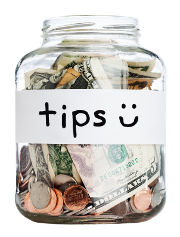
This guide is all about how to save money when buying a colored diamond - basically, about how to be a smart diamond shopper.
While most of the facts are also true for regular white diamonds, we will emphasis items that are related to colored diamonds.
Before we begin, to truly understand the language used in this guide we recommend going through our colored diamonds education section and our diamond buying guide. It holds lots of viable data (much more than the diamond 4 Cs) on diamonds in general and on colored diamonds.
How to Leverage the Diamond Pricing Methodology to Buy Diamonds Cheap
Prices in a free market are determined by supply and demand - the most basic rule of economy. This is also true with the pricing of diamonds.
The better quality diamonds are harder to find in nature and are also (naturally) more sought after - I have yet to find a person saying no to a better color diamond or a diamond of a bigger size if offered for the same price. These two facts cause a very large spike in the prices of diamonds when you climb the latter of a diamond’s quality - no matter which criteria.
In the step by step guide below we will teach you how to harness these attributes and get the maximum diamond for the less amount of money while the appearance of the diamond will remain quite the same.
Step by Step on How to Save Money When Buying Diamonds & Colored Diamonds
-
Carat does not necessarily mean size -
People automatically assume that a 1.00 carat diamond is bigger than a 0.90ct diamond. This is far from truth. Diamond carat refers to a diamond's weight - carat is a weight related measurement and does not mean size. Can’t a 120 pounds person be taller than a 140 pounds person?
As with people, the weight can be disbursed in different ways.
A diamond can have a thick girdle or a deep pavilion so that the table (the surface of the diamond as you see from the top) will be smaller yet it will weigh the same as another diamond that is cut differently (learn more about diamond cut).When looking on a GIA certificate you can see all of the necessary measurements in order to assess the diamond’s true size - compare!
In colored diamonds, diamonds are cut mainly to get the most color whereas in whites they are cut to get the most brilliance. This is why carat weight has the potential of being even more misleading.
-
Avoid carat weight steps -
Diamonds are priced per carat. The price per carat of a 1.00 carat diamond is much higher than the price per carat of a 0.90 carat diamond. Add the fact that a one carat diamond is 10% heavier and you’ll get a serious increase.
A numeric example: the price per carat for a 1 carat G SI1 is about 25% higher than an equivalent 0.90ct diamond. Add the weight difference and you’ll get to a total difference of 40%.
As can be seen in the graph below, the numbers are even more astounding when considering rarer diamonds. A 1.00 carat D Flawless costs roughly 70% more than a 0.90ct equivalent and when adding the weight it comes to a 90% difference. Whereas in medium grade diamond such as G SI1 (which is a beautiful diamond to all opinions) the increase is a lot more moderate.
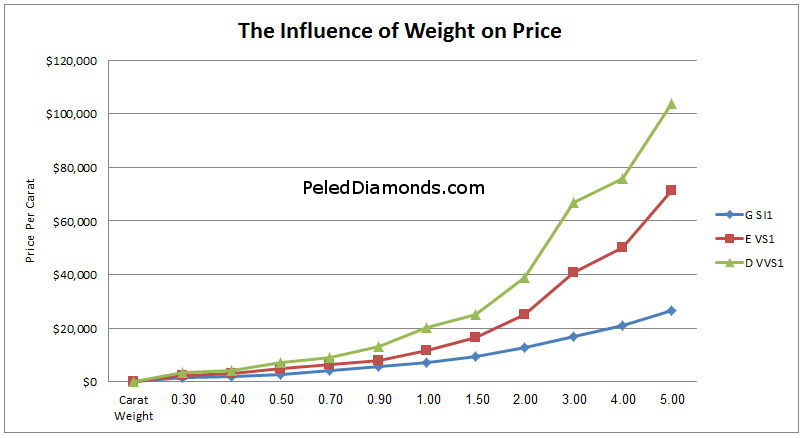 The effect of carat weight on Price per Carat
The effect of carat weight on Price per Carat
Prices should be considered as index and are not necessarily currentWhen it comes to colored diamonds that are by far rarer than regular diamonds the example of the second diamond is more accurate - the price will jump dramatically.
And in continuous to the previous advice, you also understand that it doesn’t even have to look smaller.
-
It’s all about the color -
Diamond color is a very important criteria in white diamonds and especially in colored diamonds. In whites, you may consider the setting. If you intend to mount the diamond onto a yellow gold ring then the yellow will reflect on the diamond thus going for a D color diamond will be an obsolete and you can get a lower color. Our recommendation: in white gold or platinum try to stay above G (though H may still be an option). In yellow gold, I color is ok as well.
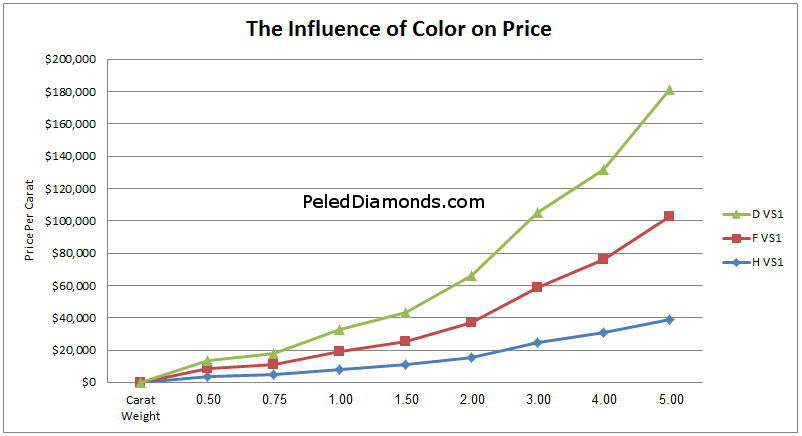 The above graph shows the price differences between diamonds of the same size and clarity but with different color
The above graph shows the price differences between diamonds of the same size and clarity but with different color
Prices should be considered as index and are not necessarily currentWhen evaluating a colored diamond special attention is given to its color, much more than in whites. There are hundreds of diamond colors. A lot of colors have a counterpart color that is similar (or related) and by far cheaper.
Generally speaking, colored diamonds prices are divided into groups. The affordable colored diamonds - Gray, Brown and Yellow (excluding vivid yellows). The medium level is made of the oranges and high quality yellows. The ultra-rare and expensive green, blue, pink, purple, violet and unmatched reds.
How to use this information?
When a colored diamond has a secondary color of an inferior grade it decreases its price. This equation works both ways: A pure Pink diamond is by far more expensive than a Brownish Pink Diamond which is a pink diamond with a slight tone of brown in it. Alternatively, a pure brown diamond is cheaper than a pink brown diamond.
Even if your heart is set on a specific color, consider those with a secondary color. The effect on the color may be negligible but on the pricing it will be very noticeable.
-
Low clarity can be your friend -
When most people think of inclusions and flaws they immediately flinch. Especially with today’s amazing technology. It enables us to show you, the customers, diamonds photographed in extremely high resolution. Suddenly, the smallest diamond can be examined in full screen size - the sentence “to examine under a microscope” is nothing compared to this. You forget that even the GIA grading is based on an x10 magnification.
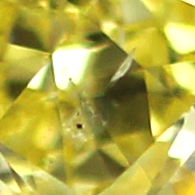
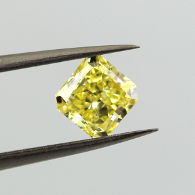
The above pictures belong to a 1.50 carat beautiful vivid yellow diamond with si2 clarity. Its price is by far cheaper than an equivalent vs clarity diamond. The picture on the left is how the inclusion seems under our website's loupe and the picture on the right is the same diamond in reduced size. Note that the actual size of the diamond is 6.5mm.
Can you see the inclusion? Is going up to VS clarity worth $10,000 to you?Don’t exclude anything till you look at it. Don’t minimize your search to a VS diamonds and above. Most SI1 diamonds and even a lot of the SI2 diamonds have inclusions that are invisible to the naked eye. Why pay to have a diamond with no inclusions that anyhow you cannot see?
This is especially true when looking on colored diamonds. If you happen to be looking for a dark colored diamond, a dark brown diamond etc., the chances are that most si2 and even I1 inclusions will barely be seen.
-
Does it have to be round?
The most expensive diamond shape is the round followed by princess cut - both have nice alternatives that will easily save you 20-50% on your money. Instead of round you can consider an oval (you can even extend your search to a fat oval with a length to width ratio as close to 1.0 as possible). Another option would be a cushion cut or a squarish cushion cut. The ideal counter for a princes cut will be a squarish radiant cut.
Here is an example of how the shape reflects on pricing:
Diamond's Shape Price Effect
Shape Weight Color Clarity Total Price Round 1.00 D VS1 $9,000 Oval 1.00 D VS1 $6,500 Round 0.50 D VS1 $1,700 Oval 0.50 D VS1 $1,350 In colored diamonds, the shape has an additional dimension to consider which causes a greater price difference.
When polishing the diamond, it is hard to retain a strong color in shapes like round and princess because of the way light goes through them.
The meaning is that a round fancy light pink would probably have gotten fancy pink if it was cut as a cushion cut and a fancy pink would have gotten intense etc.
Add the fact the rounds are hard to find and more sought after, and this is why rounds in fancy colored diamonds often cost like an intense equivalent cushion (and maybe more).
-
Fluorescence - The invisible flaw -
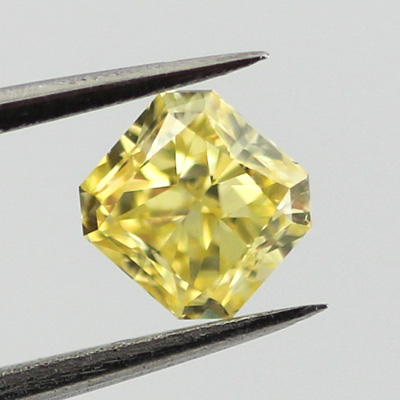 Intense Yellow Diamond with Strong Fluorescence - 30% cheaper and equally beautiful
Intense Yellow Diamond with Strong Fluorescence - 30% cheaper and equally beautiful
There are a lot of opinions in the industry about fluorescence. First thing to know is that it is considered a flaw and thus reduces the price. However, unless we are talking about strong fluorescence the chances are that you won’t know the difference (only under a UV lamp).
But in white diamonds fluorescence may become an advantage! One of the characteristics of fluorescence is that it makes diamonds appear a bit whiter. This means that you can consider buying a diamond with a lower color grade (and save money for it) and get one that is also with fluorescence (again save money on it) and the result will be a much cheaper diamond that will look the same to the untrained eye (and maybe to the trained as well).
In colored diamonds the story gets a bit more complex. If you intend to buy a yellow diamond we highly recommend reading about Fluorescence in yellow diamonds. In other colors, it is usually not taken into consideration.
-
Smart Setting -
When designing your own diamond jewelry it is important to choose a good craftsman. A good setter will know how to maximize the potential of a diamond.
If you consider buying a low clarity diamond it can be by hiding a peeling in the diamond with the prongs or hiding a feather like inclusion. A small sized pair of diamond studs will appear bigger by having a bagel setting instead of prongs setting.
In colored diamonds you can go for a weaker color (a lower cost diamond) and enhance it with the setting. Yellow diamonds are often mounted in yellow gold crowns or with yellow gold prongs (even if the hoop is in white gold). Pink Diamonds can be mounted in rose gold setting etc. This will enable you to save money on the diamond’s intensity level.
To conclude - You don’t need to buy cheap diamonds. Simply buy smart!
Make every disadvantage an advantage.
